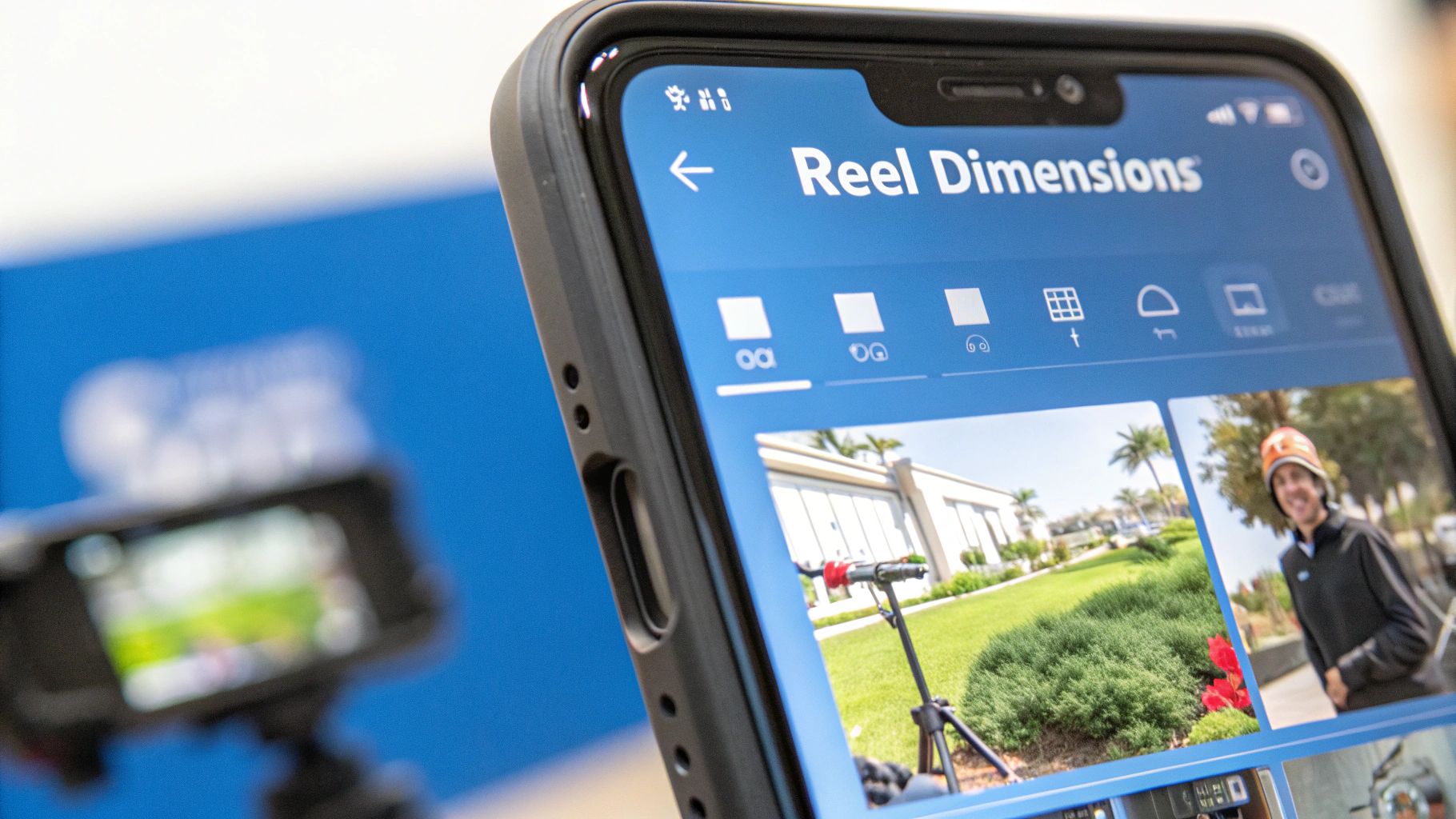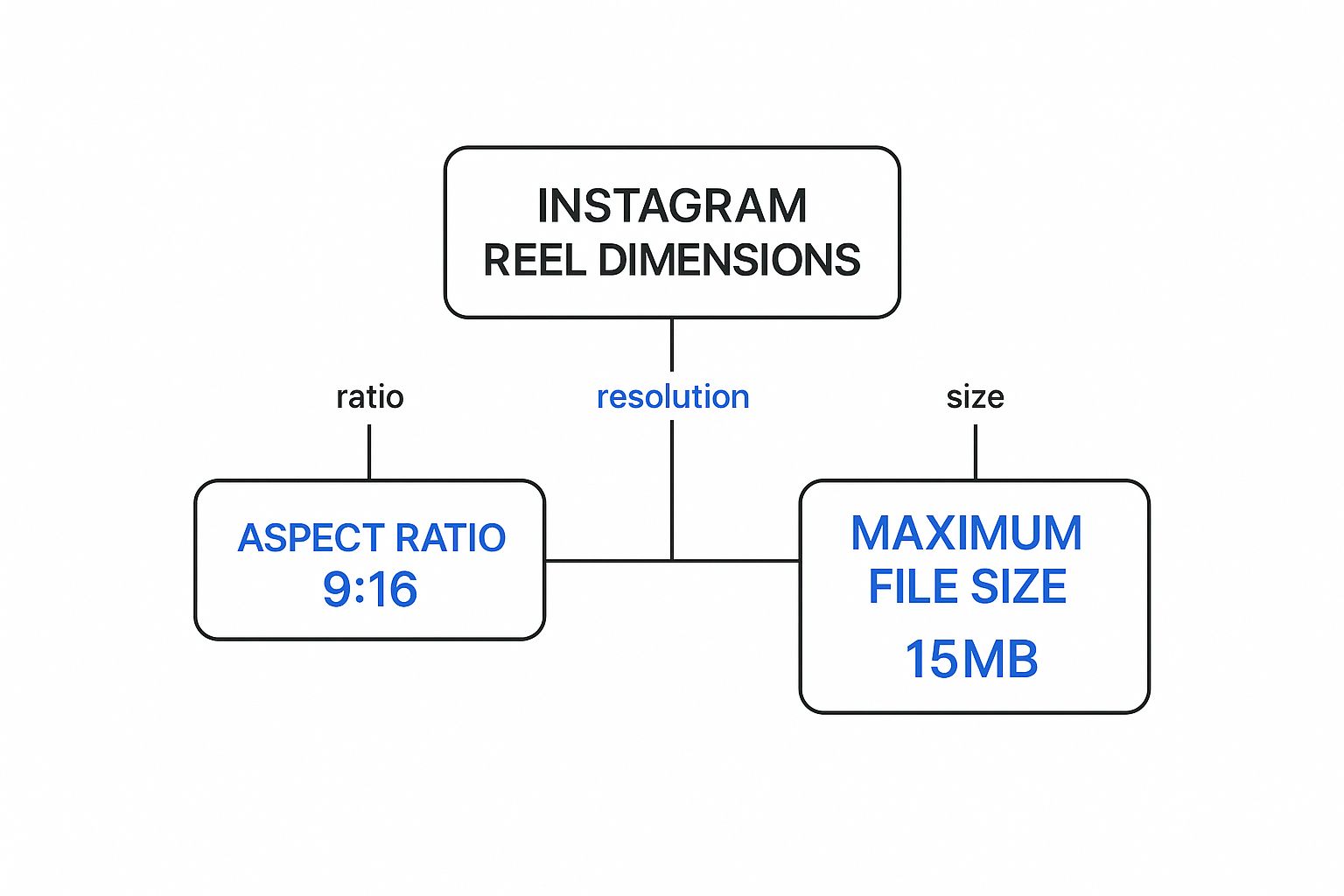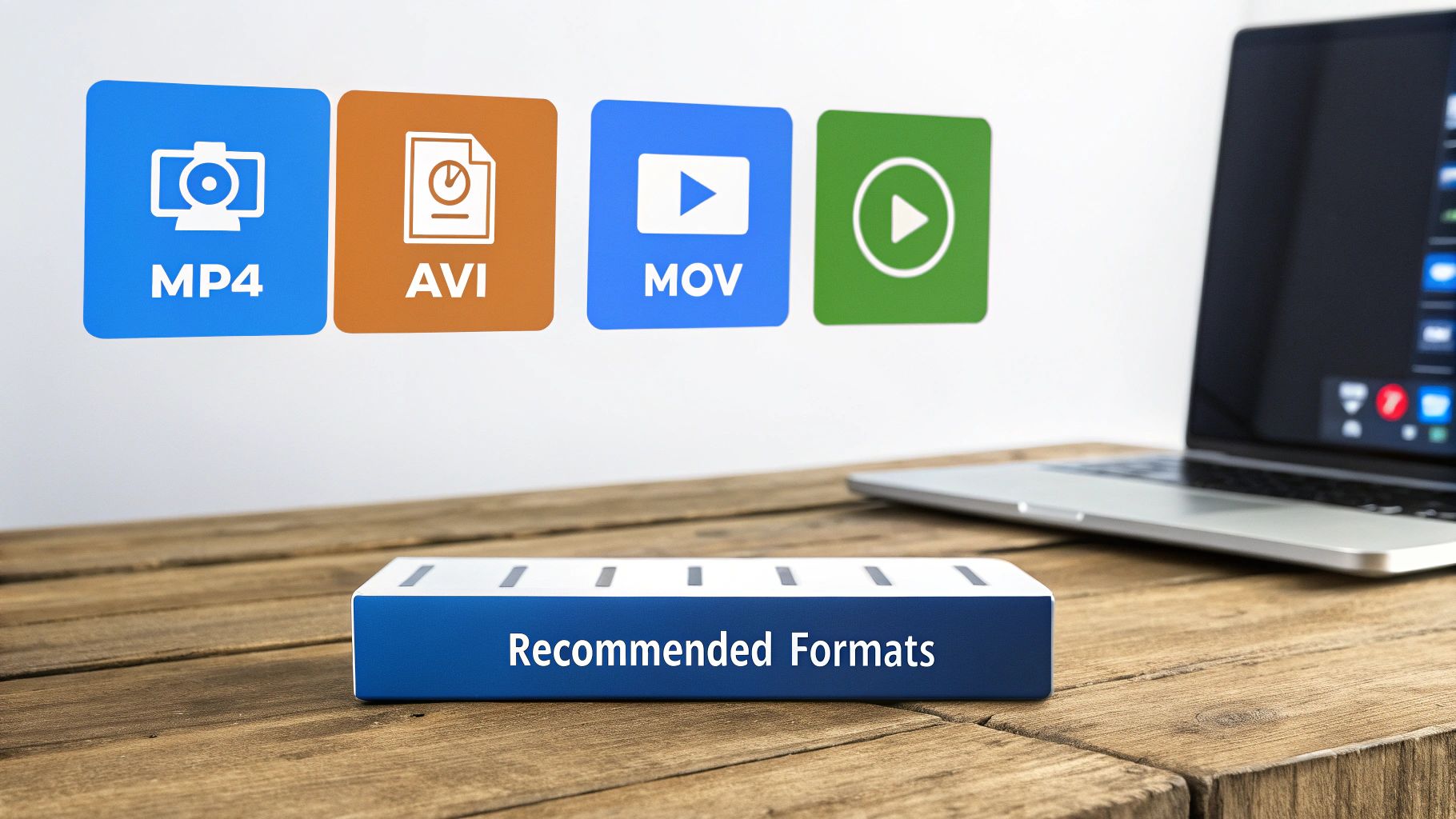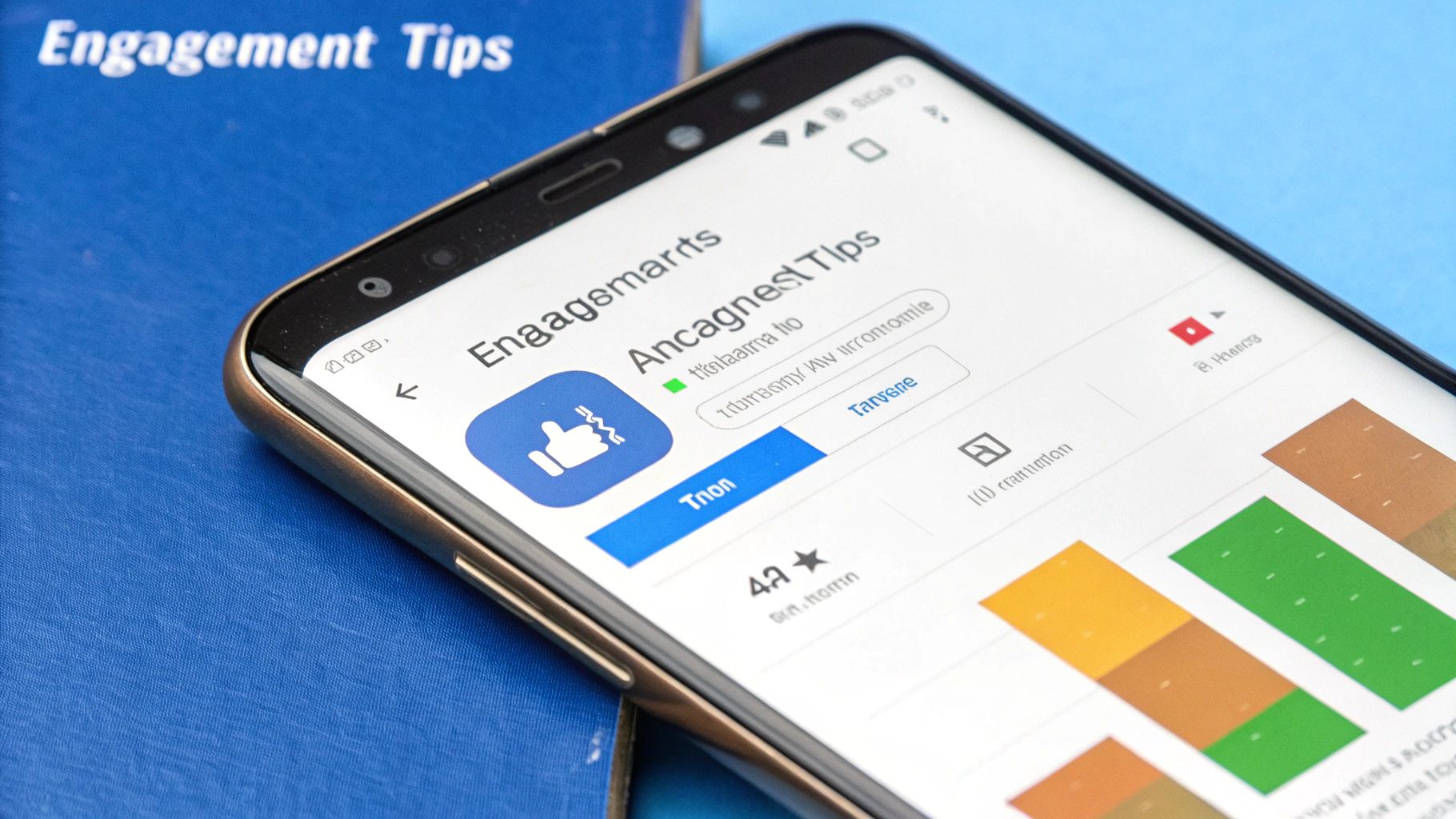If you want your Instagram Reels to look sharp and professional, the magic numbers are 1080 x 1920 pixels. This translates to a 9:16 aspect ratio, which is the standard vertical format that fills an entire mobile screen. Nailing these dimensions is your first step toward creating an immersive experience that stops people from scrolling past your content.
Your Quick Guide to Instagram Reel Dimensions

Getting your Reel dimensions right from the start saves you a ton of headaches later. To help you master the technical side of things, we've put together a quick reference guide covering all the critical specs you'll need.
This table breaks down the best settings for resolution, aspect ratio, file formats, and more. Sticking to these guidelines helps you avoid common pitfalls like blurry video, weird cropping, or upload errors. While this is specifically for Reels, you can find a broader overview in our complete guide covering all social media post dimensions.
Instagram Reels Technical Specifications at a Glance
For the best results, always aim for these settings when you're creating and exporting your Reels. This table is a simple cheat sheet with all the essential technical details you need for a perfect upload.
| Specification | Recommendation |
|---|---|
| Resolution | 1080 x 1920 pixels |
| Aspect Ratio | 9:16 (Full Screen) / 4:5 (In-Feed) |
| File Format | MP4 or MOV |
| Frame Rate | 30 FPS or 60 FPS |
| Max File Size | 4 GB |
| Video Length | Up to 90 seconds |
Pay close attention to these specs. Instagram's algorithm favors high-quality content, and properly formatted videos stand a much better chance of landing on the Explore page or the main Reels tab. This can make a huge difference in your reach.
Key Considerations for Your Reels
The ideal setup for your Instagram Reels in 2025 remains 1080 x 1920 pixels with a 9:16 aspect ratio, perfect for that full-screen mobile view. One crucial thing to remember is how your Reel appears elsewhere. On your main profile grid, for instance, the thumbnail gets cropped to a 1:1 square.
Because of this, you should always keep the most important visual elements—like text, logos, or key actions—centered in your frame. This simple practice ensures nothing critical gets cut off when someone views your profile. For the best performance, stick to MP4 or MOV file formats with an H.264 codec, keep your file size under 4 GB, and use a frame rate of either 30 or 60 FPS.
Once you've got the hang of creating your own content, you might also find it helpful to check out this guide on how to repost a Reel on Instagram for sharing user-generated content or collaborations.
Why the 9:16 Aspect Ratio Is a Must
If there's one golden rule for Instagram Reels, it's this: always use a 9:16 aspect ratio. This isn't just a suggestion; it's fundamental to how the platform works. Reels are designed for vertical, full-screen viewing on mobile phones, and 9:16 is the format that fills every pixel of that screen.
Stick to a resolution of 1080 x 1920 pixels. This ensures your video looks sharp and professional, commanding the viewer's full attention without any distracting black bars on the sides.
When you upload a video that isn't 9:16, Instagram has to make it fit. This usually means it gets awkwardly cropped, or the platform adds ugly borders to fill the empty space. Either way, you risk cutting off important parts of your video and looking like you don't know what you're doing. A properly formatted Reel just feels right—it's seamless, immersive, and keeps people watching.
Don't Forget the Safe Zone
Even though your video fills the entire screen, you can't use all of that space for critical information. Instagram overlays its interface right on top of your Reel. You'll find the like, comment, and share buttons on the right, and your profile name, caption, and audio details along the bottom.
This is why understanding the safe zone is so important. The safe zone is the central area of your frame that will always be visible, no matter what.
Pro Tip: Think of the center of your screen as prime real estate. Any crucial text, logos, product shots, or calls-to-action should live here. Placing them in this safe area guarantees your message won't get covered up by an icon or your caption.
The infographic below breaks down how aspect ratio, resolution, and file size all connect to create a perfectly optimized Reel.

As you can see, these three specs aren't independent—they work together. Nailing all three is the key to producing a high-quality video that's ready to perform well on Instagram.
Fine-Tuning Your Video Settings for Crystal-Clear Reels

Getting your Instagram Reel dimensions right is the first step, but your video export settings are what truly preserve the quality you worked so hard to create. It might seem logical to shoot in 4K and upload that massive file, but it's actually one of the worst things you can do.
Instagram’s compression algorithm is aggressive. When it sees a huge 4K file, it squeezes it down hard, often resulting in a video that looks worse than if you had just uploaded a properly sized 1080p file in the first place. For the best results, you want to give Instagram a file that’s as close to its final display format as possible.
That means you should always export your Reels with a resolution of 1080 x 1920 pixels. This is the native resolution for full-screen vertical video on the platform, which minimizes forced compression and gives you much more control over how the final video looks.
Recommended Export Settings
You don't need a Hollywood-level editing suite to get these settings right. Whether you’re cutting videos in a professional program like Adobe Premiere Pro or using a mobile app like CapCut, the core principles are the same.
Here are the ideal settings to aim for:
- Format: Stick with MP4 or MOV. They provide the best mix of high quality and manageable file size, and they're universally supported.
- Codec: The gold standard here is H.264 (AVC). It's the most common codec for web video for a reason—it’s efficient and compatible everywhere.
- Frame Rate: A frame rate of 30 FPS (Frames Per Second) is perfect for most content. If your video has a lot of fast movement or you're going for a super-smooth, cinematic feel, bump it up to 60 FPS.
A pro tip that many creators overlook is the bitrate. For a 1080p Reel, a target bitrate between 10-15 Mbps is the sweet spot. This keeps plenty of detail in your video without making the file so large that Instagram has to over-compress it.
Once you’ve got the technical side dialed in, you can focus on the creative. Combining top-notch video quality with a great content strategy is how you learn how to go viral on Instagram Reels and maximize your impact.
Mastering Reel Length and File Size

Once you’ve nailed the visual dimensions, two other technical specs come into play: how long your video can be and how big the file is. Getting these right is the difference between a smooth upload and a frustrating "file too large" error, so let's break them down.
The maximum file size for any Instagram Reel is a surprisingly beefy 4 GB. This sounds like a lot, but if you're shooting in high-resolution and adding a bunch of effects, you can hit that ceiling faster than you think. If you find your file is overweight, try lowering the video bitrate in your editing software's export settings—it’s a great way to shrink the file size without a noticeable drop in quality.
How Long Can Your Reel Be?
The maximum length for Instagram Reels isn't set in stone; it's actually evolved quite a bit. It started at 60 seconds, then Instagram bumped it up to 90 seconds to give creators more breathing room. They've even tested three-minute Reels, showing they're serious about competing with other video platforms.
It’s a smart move that gives you more space for in-depth tutorials, skits, or storytelling. You can read more about Instagram's history and its strategic feature updates in this deep dive on Wikipedia.
Pro Tip: Just because you can make a 90-second Reel doesn't always mean you should. Viewer attention is fleeting. For most content, aiming for a sweet spot between 15 and 30 seconds is the best way to keep your audience hooked until the end.
Ultimately, your video's length should serve your message, not just fill the time. And remember, what you post is only half the battle—when you post matters, too. For more on that, check out our guide on the best time to post on Instagram.
Designing Your Reel Cover and Grid Thumbnail
Your Reel's cover is its first impression, but it's a bit of a moving target. You're actually designing for two different placements simultaneously. In the Reels tab, your cover is shown in its full 9:16 glory. But pop over to your main profile grid, and Instagram crops that very same image down to a 1:1 square.
If you don't plan for this, it can get messy. Important text or visuals at the top or bottom of your 9:16 cover will simply be chopped off on your grid, which can look awkward and unprofessional. The trick is to think "center-safe" from the start.
The Center-Safe Method for Flawless Covers
To make a cover that looks fantastic in both spots, begin with a 1080 x 1920 pixel canvas—the standard for Reels. The secret sauce is placing all your critical elements, whether that's your face, a catchy title, or a product shot, squarely within the middle of that canvas.
This simple step ensures that when Instagram automatically creates the square crop for your profile grid, nothing important gets lost. You're essentially designing a perfect square image that just happens to live inside a taller, vertical rectangle.
Key Takeaway: A sharp-looking cover is what earns that first tap. By keeping your main visuals inside the central 1080 x 1080 pixel area of your 1080 x 1920 pixel canvas, you'll have a great-looking cover for the Reels feed and a perfectly framed thumbnail for your grid. No surprises.
Following this method helps you build a cohesive, professional-looking profile that invites people to stick around and see what you're all about.
Common Reel Dimension Mistakes and How to Fix Them
Even when you have a great idea for a Reel, simple technical slip-ups can seriously hurt its performance. Getting your Instagram Reel dimensions wrong can make your content look unprofessional, which is a red flag for both viewers and the Instagram algorithm.
Let’s walk through the most common mistakes I see people make and, more importantly, how to fix them so your Reels always look sharp.
Solving Common Formatting Problems
One of the most frequent blunders is trying to force a standard horizontal video into a vertical frame. Reels are designed for a vertical, full-screen experience. When you upload a 16:9 video, Instagram either slaps ugly black bars on the top and bottom or awkwardly crops it, often cutting out the most important parts of your shot.
Another classic error is placing text, stickers, or logos outside the safe zone. It's easy to forget that Instagram's interface—the caption, like button, and share icons—will cover parts of your screen. When your call-to-action or a key piece of text gets hidden, your message is lost.
Here are the most common pitfalls and how to sidestep them:
-
Mistake 1: Using Horizontal Video
- This happens when you upload footage shot in a standard 16:9 landscape format.
- The Fix: Always shoot your video vertically (9:16) right from the start. If you absolutely must use horizontal footage, bring it into a video editor, place it on a 9:16 timeline, and fill the empty space above and below with a blurred version of the video or custom graphics.
-
Mistake 2: Ignoring the Safe Zone
- This is when you place text, logos, or other critical visuals too close to the edges of the screen.
- The Fix: Keep all your essential elements firmly within the center part of the frame. Think of it as a "title-safe" area, ensuring that Instagram's UI elements won't cover up your hard work.
Key Insight: Remember, most people will first encounter your Reel in their main feed, where it's cropped to a 4:5 aspect ratio. That center-cropped view is your first and most important impression, making the safe zone absolutely critical for hooking a viewer.
Finally, don't sabotage your content by uploading a low-resolution file. Every video uploaded to Instagram gets compressed. If you start with a fuzzy or pixelated video, the compression will only make it look worse. Always export your final video at 1080p resolution to give it the best chance of looking crisp and clear after Instagram is done with it.
Still Have Questions? Here Are Some Quick Answers
Even with all the specs laid out, a few specific questions tend to pop up again and again. Think of this as your quick-reference troubleshooting guide for those last-minute worries before you hit "Share."
What Happens If My Reel Isn't 9:16?
If you upload a Reel that doesn’t fit the official 9:16 aspect ratio, Instagram will step in and try to make it fit. This usually doesn't end well for your content.
For a horizontal video, Instagram will slap black bars on the top and bottom to fill the vertical screen. For other vertical ratios that are close but not quite right, it will likely crop the video automatically, which can awkwardly cut off key parts of your shot. The only surefire way to avoid this is to set up your video at 1080 x 1920 pixels from the very beginning.
Should I Bother Recording in 4K for Reels?
Definitely not. While it might seem like a good idea to upload the highest quality file possible, it often backfires on Instagram. The platform's compression algorithms are pretty aggressive and can actually make a 4K video look worse than a standard 1080p one after it's been processed.
By giving Instagram a file that’s already optimized for its platform, you have much more control over how the final video looks.
How Can I Check My Video's Dimensions?
It’s pretty simple to check your video's specs.
- On a computer: Just right-click the video file and choose "Properties" on Windows or "Get Info" on a Mac. The dimensions will be listed in the details.
- On mobile: Most video editing apps, like CapCut or InShot, show the resolution and aspect ratio right in the export settings. It’s a crucial final check before you save.
The best practice is to start your project correctly from the get-go. Always create a new project in your editing app with a 1080 x 1920 canvas before you even import your clips. This prevents any sizing headaches later on.
Can I Change My Reel Cover After I've Posted It?
Nope, once a Reel is live, the cover is locked in. You can’t change it. This makes it incredibly important to get it right the first time.
You have to choose your cover—either a single frame from the video or a custom image you’ve designed—right before you publish. A great cover is key for a professional-looking grid and can seriously increase your Instagram engagement by enticing people to click play.